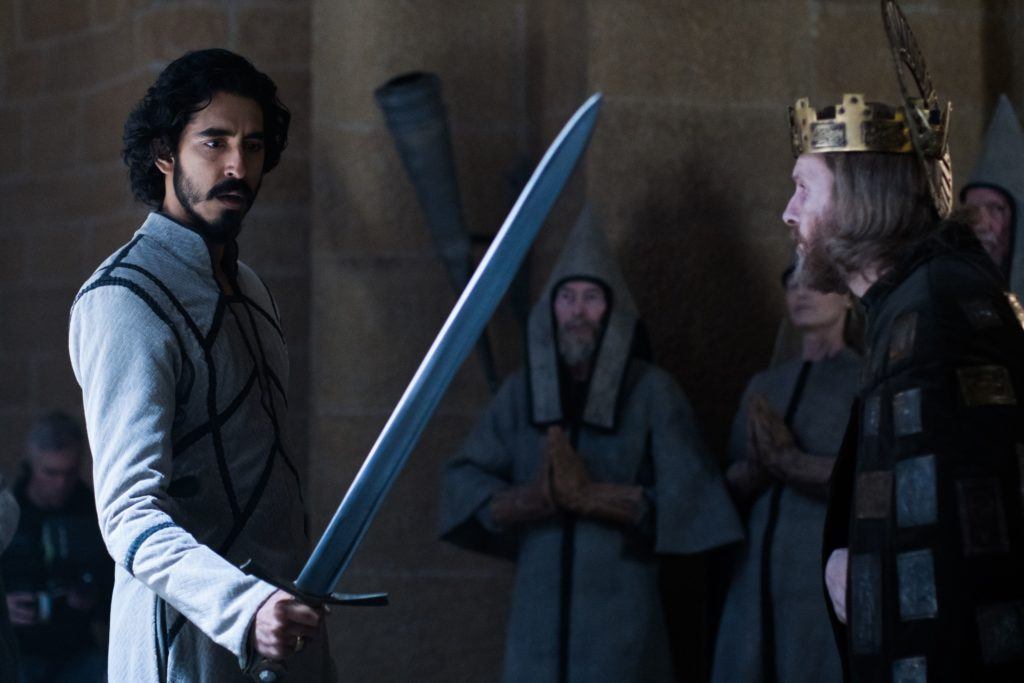The Green Knight

Image courtesy A24.
“Look, see your world that holds more wonders than any since the Earth was born. And of all who reigned, none had renown like the boy who pulled sword from stone. But this is not that king, nor is this his song.”
A mandolin strums along with the beat of water droplets from the window. One’s house is on fire.
Gawain (Dev Patel) awakes in his chambers, after a night of revelry with a girlfriend, Essel (Alicia Vikander); she never appears in the original text (added here, perhaps, to humanize him). His mother, Morgana (Sarita Choudhury), exclaims, “You do smell like you’ve been drinking the sacrament all night.”
Unlike the original works of Malory and Chaucer in the thirteenth century, Sir Gawain and the Green Knight, while canonically accepted in the The Matter of Britain, was penned anonymously. Twenty works in total arose in the two centuries following Le Morte d’Arthur. One could argue these were early examples of fan fiction.
Adapted from the fourteenth century chivalric romance, THE GREEN KNIGHT translates to screen, largely in a West Midlands dialect1, under the direction and writing of David Lowery. On Christmas Day, Gawain, is taken to see his uncle, Arthur (Sean Harris)—the aging king. There, he’s challenged by the Green Knight. The Knight allows Gawain a blow in exchange for the same blow “one year hence.”
He beheads the cursed Knight, who bellows with laughter, knowing that Gawain committed himself in kind. A year quickly passes, and the anxious young man begins his journey to meet the verdant Lord at the Green Chapel. Before he makes his journey, his mother bestows upon him an enchanted girdle to protect him from harm.
As our young Gawain goes forth to meet his fate, the film scatters the fantastical amidst the ordinary—incantations, possessions, flaming heads, animated corpses, talking foxes—as metaphor for man’s struggle to control the laws of nature². It’s not meant to be taken purely at face value, hence Arthur’s warning to Gawain, “Remember, it is only a game.”
Gawain, like us, cannot be sure of what he sees. Is his mind playing tricks on him, or is someone else? After hallucinating his own demise at the hands of robbers, Gawain receives the hospitality of another Lord (Joel Edgerton) and Lady (Alicia Vikander). Notes of reciprocity repeat here, lending to our suspicion that the coming twist isn’t the point. That’s refreshing, as is the film’s use of visual metaphor amidst all the subtextually-bereft cinema of late. Lowery’s reluctance to fully embrace the queer subtext of the source trades one kind of tension for another—rather than confronting his attraction to the Lord, Gawain flinches.
While it nods to the visual and psychological mood of Boorman’s EXCALIBUR, THE GREEN KNIGHT shares philosophical underpinnings with my own ancestral legends, most notably the Mahabharata, in which the universal law, Dharma, presides omnipresent over factions, wars and empires that come and go. The Lady describes this interdependency, “Red is the color of lust. Green is what lust leaves behind.”
The saffr0n robes of Gawain and his mother (both played by British descendants of the Indian diaspora) contrast with verdigris, a color developed by the Romans³ from pigments acquired through their conquest of Egypt. There’s a through-line here about colonial imperialism, and how, unlike life being the byproduct of lust for human connection, lust for power leaves only death and destruction in its wake. But we also see the the consequences of over-protectiveness, which taken to extremes is paternalistic imperialism. Wrapped in his mothers magical cloths, under a Turmeric mist, Gawain sees a vision of his future and the consequences of unchecked lust for everlasting life and power.
Like Peter Brook’s stage and film adaptations of Vyasa’s epic poem, also about balancing choices and their consequences, the multi-cultural casting works hand in hand with this story’s universal themes. Choudhury’s Morgana breaks multiple stereotypes of South Asian women and women in general. I’m reminded of Dame Helen Mirren as Prospera in Julie Taymor’s THE TEMPEST. Dev Patel performs beautifully in all capacities: as nephew to the King, knight-adventurer, and weary ruler of a pointlessly-expanding empire. In the end, the protagonist is left to contemplate in silence the cosmic totality of it all.
Early in the narrative, when Gawain first confronts the Knight, he knocks over a goblet of wine, which spills across the relief on the floor in a color as rich and thick as blood. The Green Knight lays down his axe, and life springs forth from it. Green is the color of magic, of nature—symbolizing forces beyond our total control. Our illusion of control over the environment is fleeting.
Chief among the tale’s many lessons, self-reliance is another kind of illusion. Campbell seemed to know this. In his analysis of the monomyth, Campbell concludes, “The community today is the planet, not the bounded nation.”
We need nature, and nature needs us. But we haven’t kept our end of the bargain.
- The dialect of the original tale is similar to the West Midland dialect of Shakespeare, which some scholars now refer to as Original Pronunciation.
- It’s also worth observing that the Matter of Britain concerns the fictionalized history spanning between Roman occupation and the Norman Conquest, rewriting the barbarian history of the Anglo-Saxons juxtaposed against the mystical rituals of the Celtic peoples.
- Arthur’s mythology takes place when, in reality, the Romans occupied what are now the British Isles.